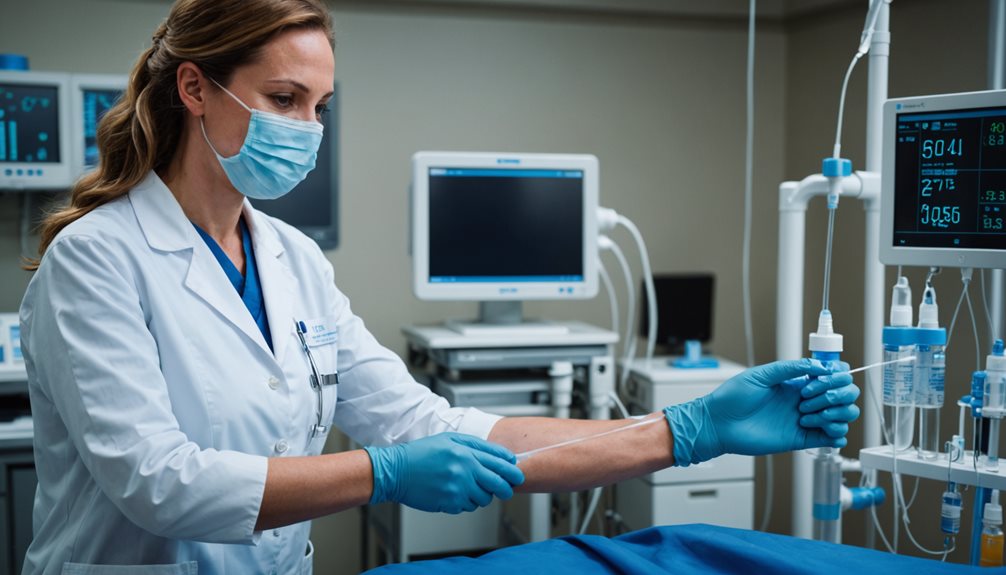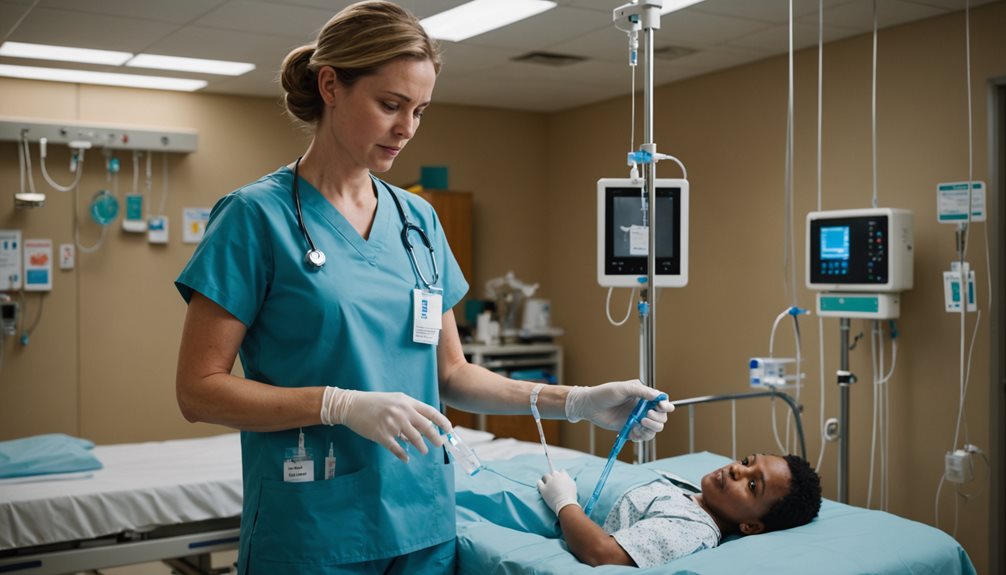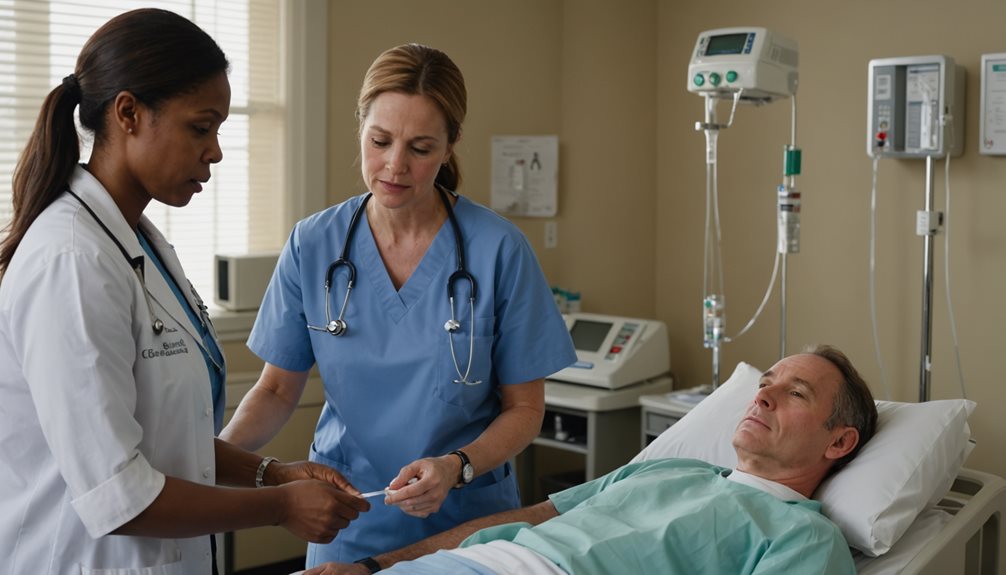When you’re caring for someone on total parenteral nutrition, your responsibilities go beyond just managing an IV. You need to track their daily weight, keep an eye on blood glucose, and watch for infection at the catheter site. These actions help you spot complications early and keep the patient safe. But there’s more to effective TPN care than just monitoring numbers—let’s consider what else you need to do to support the best possible outcome.
Key Takeaways
- Monitor and record daily weights and blood glucose levels every 4 to 6 hours to detect hyperglycemia or fluid overload.
- Assess laboratory values regularly, including electrolytes and liver function tests, to ensure metabolic requirements are met.
- Inspect the TPN administration site and IV catheter for signs of infection, swelling, or thrombosis.
- Use dedicated IV tubing with a filter for TPN, replacing the solution and tubing every 24 hours to maintain sterility.
- Strictly adhere to aseptic and sterile techniques during TPN preparation and administration to minimize infection risk.
Key Components of Total Parenteral Nutrition

Total parenteral nutrition (TPN) is a method of delivering essential nutrients directly into the bloodstream, bypassing the digestive system.
The TPN solution is formulated to include carbohydrates, proteins, fats, vitamins, and minerals, with the composition individualized according to the patient’s specific nutritional needs. Electrolytes such as sodium, potassium, and calcium are regularly adjusted based on ongoing clinical and laboratory assessments.
Because TPN solutions are hypertonic, they’re administered through a central venous catheter to minimize the risk of complications. Continuous monitoring of blood glucose levels and body weight is necessary to detect and manage potential adverse effects, such as metabolic imbalances or fluid overload.
TPN is typically managed by healthcare professionals to ensure that patients receive adequate nutrition and maintain proper physiologic stability.
Essential Nursing Assessments for TPN Clients
Total parenteral nutrition (TPN) bypasses the gastrointestinal tract, requiring specific nursing assessments to identify potential complications and evaluate the effectiveness of therapy.
Nurses should monitor the client’s weight on a daily basis to assess nutritional status and detect any signs of fluid overload. Blood glucose levels must be checked every 4 to 6 hours, as TPN administration can lead to hyperglycemia.
Regular evaluation of laboratory results, including electrolytes and liver function tests, is necessary to ensure metabolic requirements are being met and to identify early signs of imbalance or organ dysfunction.
The TPN administration site should be inspected routinely for evidence of infection, with strict adherence to sterile technique to reduce infection risk.
Additionally, patients—particularly those who are malnourished and beginning nutrition after a period of fasting—should be monitored for refeeding syndrome, which can involve dangerous shifts in fluids and electrolytes.
These assessments are essential for maintaining patient safety and supporting optimal outcomes during TPN therapy.
Monitoring and Managing Complications
When caring for clients receiving total parenteral nutrition (TPN), it’s important to monitor for complications that may arise.
Blood glucose levels should be checked every 4 to 6 hours due to the increased risk of hyperglycemia associated with TPN’s high dextrose content. Daily weight measurements are recommended to assess for changes that could indicate fluid imbalance.
The IV catheter site must be regularly inspected for signs of infection, such as redness, swelling, or purulent discharge. If swelling is observed above a peripherally inserted central catheter (PICC) site, measuring the upper arm circumference can help detect thrombosis.
Monitoring for refeeding syndrome is also necessary, particularly in relation to potential electrolyte imbalances when initiating TPN. Early identification and intervention for these complications are essential in maintaining patient safety.
Safe Administration Practices for TPN

Monitoring for complications is an important aspect of safe total parenteral nutrition (TPN) administration. The method of administering TPN significantly influences patient outcomes.
It’s essential to use dedicated IV tubing for TPN, and to incorporate a filter to reduce the risk of particle and bacterial contamination, which can contribute to infection. Both the TPN solution and the IV tubing should be replaced every 24 hours regardless of whether the solution is completely infused, in order to maintain sterility.
Adhering to strict sterile technique at each step of the process further minimizes infection risks. Additionally, blood glucose levels should be checked every 4 to 6 hours, as regular monitoring facilitates timely adjustment in response to changes in glucose levels during TPN therapy.
Importance of Regular Laboratory and Weight Monitoring
Regular monitoring of laboratory values and body weight is essential for the safe and effective administration of total parenteral nutrition (TPN). Blood glucose should be assessed every 4 to 6 hours to identify and manage hyperglycemia promptly.
Daily weight measurements provide information about the patient’s fluid balance and help ensure that nutritional goals are being met; significant fluctuations may suggest complications such as fluid overload or dehydration.
It’s also important to monitor electrolytes, including sodium and potassium, to reduce the risk of developing electrolyte imbalances.
Weekly measurement of prealbumin levels can provide insight into the patient’s protein status and support decisions regarding adjustments in TPN composition.
Infection Prevention Strategies in TPN Therapy
Total parenteral nutrition (TPN) therapy is associated with an increased risk of infection, primarily due to the requirement for central venous access and repeated manipulation of catheter systems.
Effective infection prevention strategies include the use of aseptic technique during the preparation and administration of TPN solutions, as well as when managing intravenous tubing. TPN solution bags and associated IV tubing should be replaced at least every 24 hours to minimize microbial contamination.
It’s recommended to use a dedicated IV line for administering TPN to reduce the risk of cross-contamination with other medications or fluids.
Routine assessment of the catheter insertion site for signs of infection, such as erythema, swelling, or discharge, is essential, and any abnormalities should be promptly reported.
Maintaining consistent hand hygiene is a critical measure for reducing infection risk in patients receiving TPN therapy.
These practices are supported by clinical guidelines and are integral to safe and effective TPN management.
Client Education and Communication

Effective infection prevention is essential for safe total parenteral nutrition (TPN) therapy, but client education and communication are also important for managing potential risks and optimizing outcomes.
TPN requires a dedicated intravenous (IV) line to reduce the likelihood of complications and infections. Regular monitoring of blood glucose levels is necessary, as the carbohydrate content in TPN may lead to hyperglycemia.
Daily weight measurements can help assess both nutritional status and fluid balance. It’s important to be aware of the risk for electrolyte imbalances and to promptly report any unusual symptoms to the healthcare team.
Maintaining open communication with healthcare providers about any concerns relating to TPN, such as infusion rates or side effects, can help ensure the safe and effective management of therapy.
Interdisciplinary Collaboration in TPN Management
Effective management of total parenteral nutrition (TPN) relies on systematic interdisciplinary collaboration among nurses, dietitians, pharmacists, and physicians.
Dietitians play a critical role in evaluating client nutritional status and requirements, formulating individualized TPN regimens based on current clinical data.
Pharmacists are responsible for verifying TPN component compatibility and monitoring for potential drug-nutrient interactions.
Physicians provide oversight by assessing the client’s broader clinical condition and determining the appropriateness of ongoing TPN therapy.
Regular interdisciplinary communication, such as scheduled team meetings and updates, facilitates prompt recognition of client status changes and supports timely adjustments to TPN plans.
Consistent and detailed documentation of collaborative decisions supports continuity of care and ensures that modifications to nutritional management are clearly recorded and accessible to all team members.
 Mindful Vitals This is a blog about health.
Mindful Vitals This is a blog about health.

